“My grandkids and my daughter, when the fire came to the edge of our house, they were screaming. It’s been nine days now since our forest was destroyed by fire. It was a very sad scene, because it’s where we hunted, where we preserved our forest… Now it’s ashes day and night. The dead animals, like the Tortoise who doesn’t run, who walks slowly. The Deer, the Armadillo, they went looking for other forest, because everything here caught fire. Children in here suffering, from this smoke, having respiratory problems, coughing. We have elderly people. All the smoke came our way. If they had been made of straw, I don’t think there would have been a single house standing.”
In a shaky voice, the sadness catching in her throat, Luzileizer Duarte Brito Tavares talks about the March 13 fire that devoured most of the homes of the Anzol Indigenous community, an Indigenous territory that has yet to be demarcated. Covering approximately 20 square kilometers, it is 70 kilometers from Boa Vista, Roraima’s state capital. Luzileizer, 38, is a local deputy coordinator for the Macuxi women. She walks with SUMAÚMA’s reporting team and her daughter, two-year-old Ruth Ester, through an ashen landscape.

InfogrAPHIC: Rodolfo Almeida/SUMAÚMA
The beauty of the morning, the afternoon and the night, hued by sunlight and moonlight, and the tones of the birds and all forms of Nature were clouded by the intense smoke that overtook Roraima in the Brazilian Amazon. The fire spread through the crops, consisting of an open area of native plants typical to the region, and went through the forest and even through backyards in the city of Boa Vista. Black clouds darkened the city on the last Sunday in March. The smoke, coming from several corners of the state and from the neighboring country of Guyana, and the heat provoked a distressing and frightful feeling. The signs of destruction and the fight to preserve life were everywhere.
Just in the first four months of this year (from January 1 to April 14), Roraima was the stage for 4,481 fires, according to Brazil’s National Institute for Space Research. Nearly 30% of the country’s fires burned in the state. The trail left by fire in Roraima was 285% bigger than in the same period in 2023, the result of a joint variety of factors, including the climate crisis, deforestation and illegal fires.
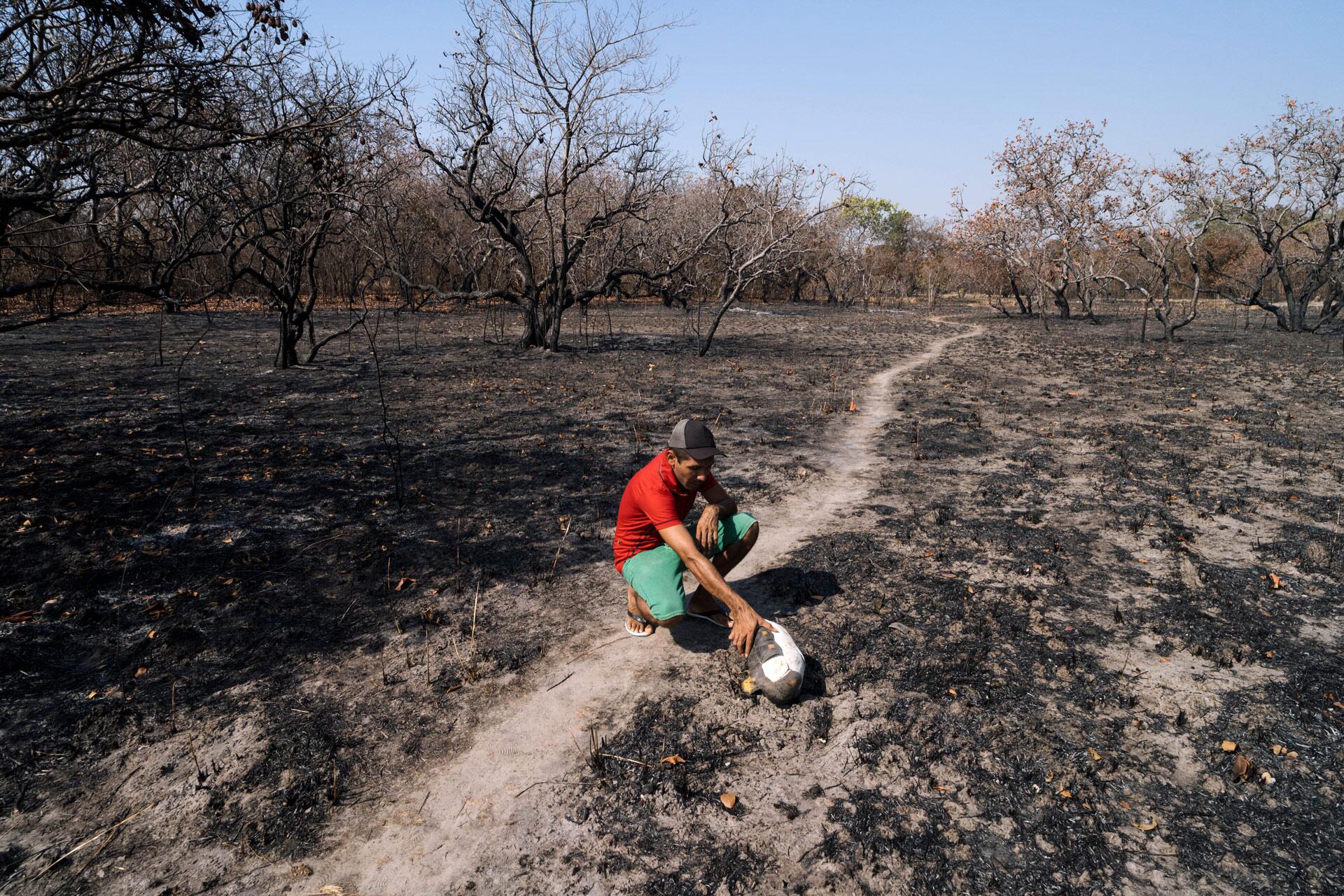
Finding dead animals along the way, like this Tortoise who had no time to escape the fire, is the saddest aspect for Dewelkelleson Bezerra, the main leader in Anzol
Heading toward Anzol, the natural landscape, made up of native plants like the Caimbé and Hogberry, gave way to dry Grass, most of it already burned. We progressed through the devastation of the ethno-region known as Murupu, formed of five communities: Serra da Moça, Morcego, Truaru da Cabeceira, Truaru da Serra, and Anzol. Dewelkelleson da Conceição Bezerra, a young man and a Tuxaua from the Anzol Indigenous community, spoke with SUMAÚMA’s reporters. Tuxaua is the word used by some Indigenous peoples to refer to their main leader.
With the Indigenous population’s consent, and led by the Anzol leader, we moved into the area destroyed by the fire. Erialdo da Silva Tavares, an Indigenous basic sanitation agent who provides support to the health post and takes care of the water supply, accompanied us. On the day of the fire, Erialdo carried water and provided support for Indigenous firefighters who were fighting the blaze with scarce resources.
Luzileizer told us about the fear and distress she felt while she watched the fire advance. She was afraid her home would be destroyed. All that remains over 1,200 meters is ash, dry leaves, and animal remains. Homes are intact, but the images of tortoise and porcupine bodies are burned into residents’ memories. “The fire didn’t come from the community. This wasn’t the community’s fault, because we were staunch advocates of controlling fire, of being careful. And when it comes, the fire comes from the farm area and destroys what we were caring for. This makes us very sad, especially because of the game,” the leader says. He also feels bad about the plants destroyed. “The ‘hardwood’ is the Bloodwood [regional tree], that we cut to build homes, for firewood, and other fruit trees, like the Hogberry, Diesel Tree, Strawberry Guava, and Jenipap, plants that we use in our culture. This was our big loss.”
The Anzol Indigenous community, with its 14 families and its population of 59 people, mostly children and older people, is part of the Serra da Moça Indigenous Territory. Because this area was left out of the 1991 demarcation of Indigenous territories, for ten years its people have been waging a battle in the courts against the FIT Manejo Florestal company. Because of this lack of territorial definition, Anzol’s residents live confined, without any water sources or forest areas. They survive through subsistence agriculture, using small areas of around 1,500 square meters to produce bananas, bitter cassava [for making cassava flour and beiju flour], and sweet cassava, in addition to raising small animals, like pigs and chickens. With the drought and the spread of fires, the community had little space and was unable to produce food at a sufficient scale to consistently feed all of its residents. This has left them the sole alternative of buying food in the city. To make matters worse, sweet and bitter cassava seeds were lost in the fire, putting the population’s way of life at risk. Everything was eaten by the fire.

Porcupines, Deer, Armadillos, and other animals tried to escape the heat and fire and look for ‘other forest,’ but most did not make it
Although Anzol sits on the shores of the Uraricoera River, one of the state’s main waterways, the water is difficult to access and became even more so during the drought. The streams dried up – this had not happened in the last four years. There is only one artesian well supplying the community with water. Erialdo, who looks after the water supply, has already warned of the risk of that vital source running dry. He says the community center’s water tank used to take an hour and a half to fill. Now, during this dry spell, it takes five hours. The artesian well, which supplies the tank, is no longer able to meet the residents’ needs.
“Our well is running dry. With the fire, then everything was done. We have to store water to make it. The summer is intense and there is no rain in the forecast. And we’re fighting, raising people’s awareness not to light fires, because it’s a crime. It doesn’t just affect us, it affects the whole planet,” Erialdo warns.
On the day of the fire, Raimundo Nonato de Souza, 58, came face to face with the flames. “It was tense for around ten hours. It was really terrible, if nobody were here, and without people’s help, my shack would have burned down. It was all day long, a furious rush, people running with water… The fire came heading toward my chicken coop, almost everything burned. A lot of smoke, I’m sick to this day, because of the excessive heat. I was never like this, ill the whole time, after this smoke I became anxious. It gave me cold sweats, headaches,” he says. Raimundo lives in the only house on the island near a project to plant beans irrigated by solar panels, carried out with the support of the Indigenous Council of Roraima, an area consumed by the fire. The water used for irrigation came from the stream. The drought has paralyzed the project.
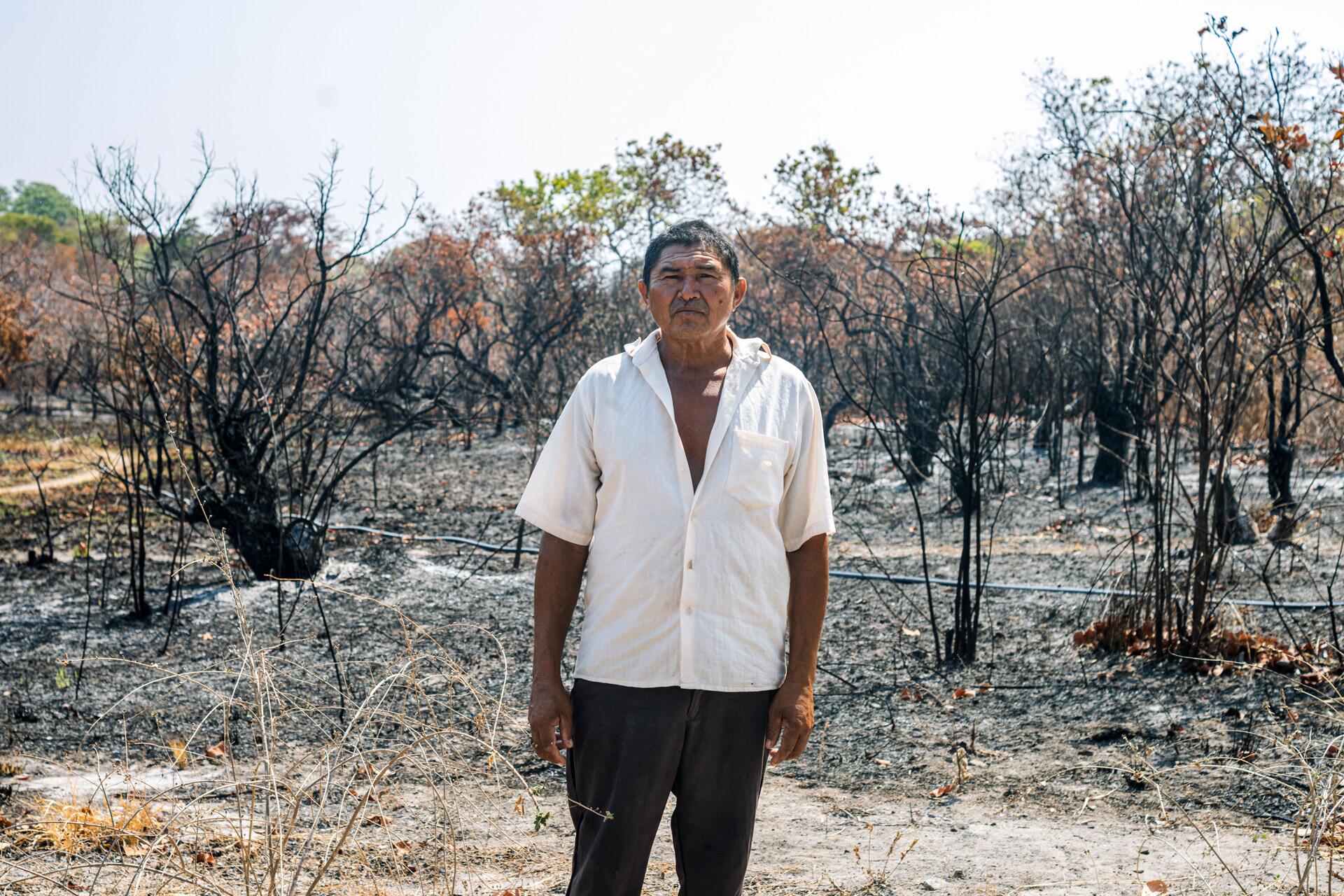
Raimundo Nonato says that to this day he has headaches and fevers because of the smoke and heat. ‘I’m sick,’ he says
Cleide da Conceição Duarte, 68, is one of the oldest residents of Anzol and the daughter of the community’s patriarch, Alfredo Duarte. Those listening to Cleide describe what happened on March 13 see a scenario that looks like the end of the world. She thought she would “lose it all.” She was unable to participate in the joint effort to put out the fire, but she saw women and children working hard. After the fire, she had a lot of headaches, coughing, vomiting, and body aches. Through a mask, she told SUMAÚMA’s reporters how “we used to have small areas of crops, but the fire ate it all. The sweet and bitter cassava ‘fluffed’ [a state where the plant is so dry that no flour can be made from it], the banana trees were killed by the fire.” Cleide recalls when the community held a “controlled burn of crop areas.” At the time it was raining and they were producing. Now, it’s “just heat and lots of fire.” Cassava flour, a staple of the Indigenous diet, is starting to run out.
With the drought and fires impacting their subsistence production, the community of Anzol is still looking for ways to pick itself back up. The weather has killed what little was left of the cassava seeds, the community’s leader says. Now they will have to look for more in other communities. Without any attention from government agencies, Anzol’s residents are looking to partners, such as Indigenous organizations, entities and communities, to help fulfill basic needs.
And the trees turned to weeds
“Why did it burn like this?” asks Wanderley da Silva Pereira, the regional coordinator of the Indigenous Territory Protection and Surveillance Group, as if he were asking himself a question. A former leader of the Malacacheta community of Wapichana people, he traveled with SUMAÚMA to a firefighting support base 60 kilometers from Boa Vista that was built by Indigenous firefighters with the help of agents from Brazilian environmental agency Ibama’s National Center to Prevent and Fight Forest Fires. This firefighting initiative also relies on support from the Malacacheta Indigenous community, the Indigenous Council of Roraima, the Socioenvironmental Institute (ISA), and Ibama.
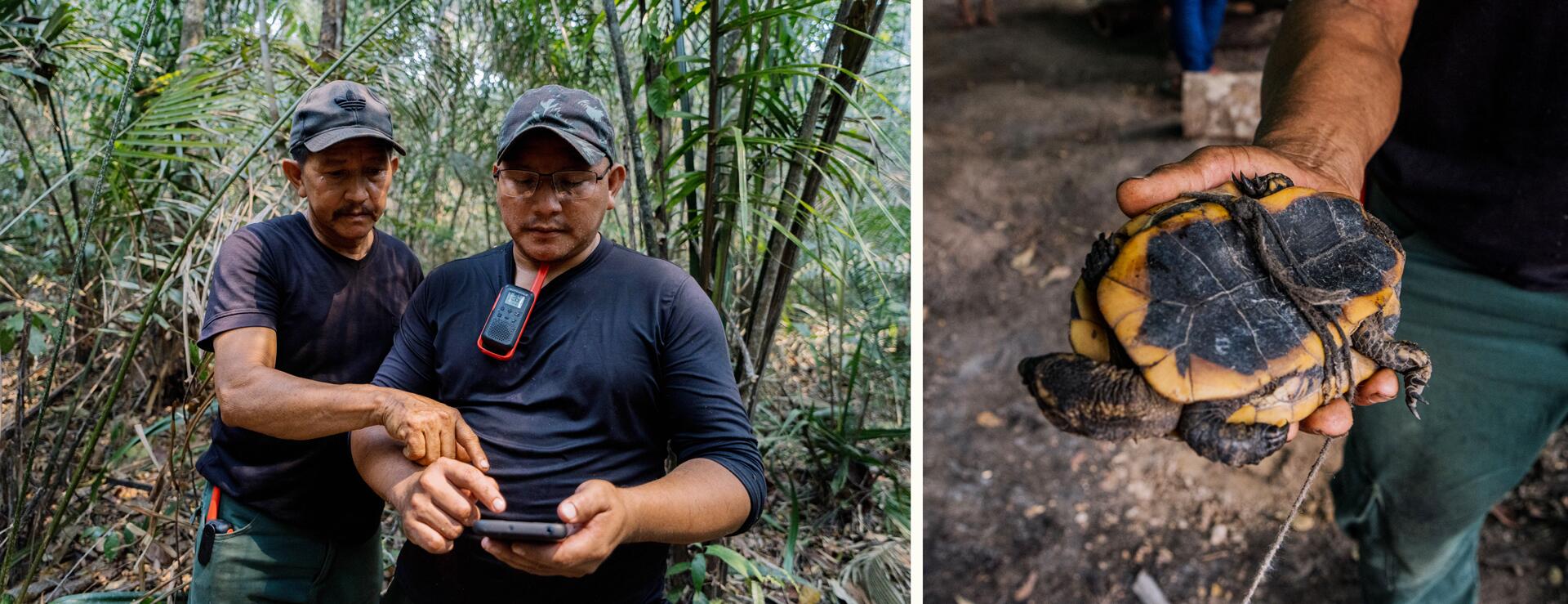
Wanderley da Silva Pereira (at left) and his son Janderley, two generations of Indigenous firefighters fighting to preserve the territories and against a dearth of public policies
Wanderley has already seen plenty of fires spread across Roraima, but he is disturbed by the forest’s death. “There was a fire, nobody knows from where. It was old-growth forest, there had never been a fire, and lots of trees died, like Bulletwood, Courbaril, Cumaru trees. Some fell, others dried up. And with this new fire, it’s turned to weeds, just bush. If surveillance and the firefighters don’t have support, we’re going to see a wood-free mountain range, just rock,” he says. By way of example, he mentions the Curupira Mountain Range, located on private property near Malacacheta Indigenous Territory. This name, Curupira, comes from the Indigenous people, because the area only has rocks.
According to the Protection Group coordinator, over a month ago there was an area burning non-stop at the Tatajuba Resettlement Area, seven kilometers away. “It came into the territory, taking an environmental preservation area. Then, this fire came from outside and spread,” he says. Wanderley is asking the government for an advance firefighting plan. “Every year there is a winter and a summer. We don’t expect, don’t need the state, federal and even the municipal government in specific to be these partners, because we aren’t [partners] today.”
Environmental regulator Ibama’s National Center to Prevent and Fight Forest Fires says it works in partnership with states and municipalities to prevent and fight fire, which is essential to trying to protect forest areas. Yet it underscores that the lowest rates of rainfall in the last 24 years were seen from August to September 2023. “Climate change is indicated as a critical factor in the rise of fire events, considering El Niño as an additional risk factor because of its relationship to the prolonged drought in the region,” it told SUMAÚMA. The team at the National Center to Prevent and Fight Forest Fires now has over 300 firefighters, and four aircraft are being used to help fight fires. Because of climate change, the environmental agency says it hired 17 more firefighters than in 2023 and 49 more than in 2022.
Those inside the forest are calling attention to the lack of government action. When asked for a statement by SUMAÚMA, the municipal government of Boa Vista – which is responsible for the Anzol community – wrote in a statement that actions to contain fire have been adopted since October 2023, the most relevant of which was the creation of a fire prevention and combat patrol in the rural and Indigenous zone of the city. A municipal government committee is asking the public to follow health recommendations including the use of masks to mitigate impacts from smoke.
The government of Roraima says that effective firefighting is done, with 300 active Fire Corps members. “In the field are nine fire trucks, 29 pickups with forest fire fighting kits, two troop transport vehicles, and two cargo trucks, along with four drones used to visualize affected areas,” the press agent said in a statement sent to SUMAÚMA. Reinforcements had to be called up from the federal government for Roraima’s Firefighting Corps, “considering that some burns, fires, and droughts also occur in areas under federal authority.”
A state of emergency was then declared in the state, since which 240 firefighters have been hired to bulk up firefighting operations. Since October 2023, firefighters have carried out 2,041 actions of this kind.
The reality on the ground tells a story of shortages. Inside the forest, a group of Indigenous firefighters and firefighters from the National Center to Prevent and Fight Forest Fires make a “line of defense,” traditionally known as a firebreak, a cut 150 to 200 meters away from the fire. It is one strategy that can be used to stop fire from advancing into the territory. Working tirelessly to protect the woods and forests, the 56 Indigenous firefighters of Roraima labour under precarious conditions. They use blowers, sickles, knapsack sprayers, and chain saws. One of the main difficulties is the lack of water.
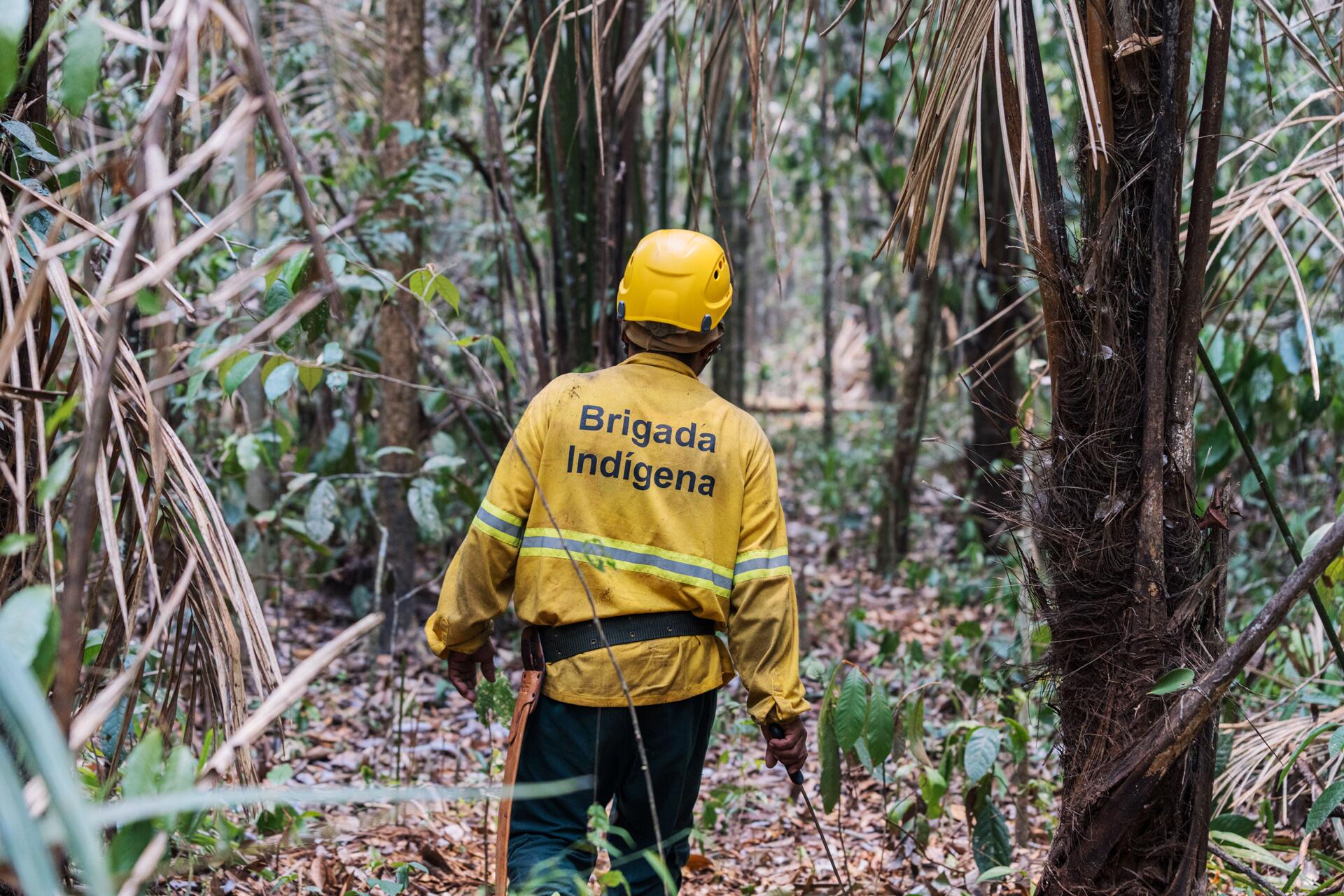
Indigenous firefighters and firefighters from the National Center for to Prevent and Fight Forest Fires, which is run by Brazil’s environmental agency Ibama, work together to build firebreaks
Janderley de Souza Pereira, 34, is Wanderley’s first son and he is also an Indigenous health agent, following in his father’s footsteps in fighting fire and conserving territory. “The earth’s situation makes us sad. Since I was 12, we’ve been defending, cleaning, and fighting against fires. The feeling is sadness at losing many trees that over time our grandparents used to tap for balata latex, they collected Cumaru fruit, and today there’s practically no more.” The initiative, he says, is trying to “save what we have.”
The fires that hit the Anzol community, as well as many other territories in Roraima, expose the lack of structure and public planning in firefighting actions. The federal government’s support is minimal. State and municipal support is almost non-existent, the communities say. It is the Indigenous people, residents, and local organizations that are joining forces to extinguish the fires in the fields. Keeping the forest standing, far from the threats that grow worse with the climate emergency, has required more and more collective action in defense of life and the planet. Yet the fire moves forward – and at much greater speed than government actions.
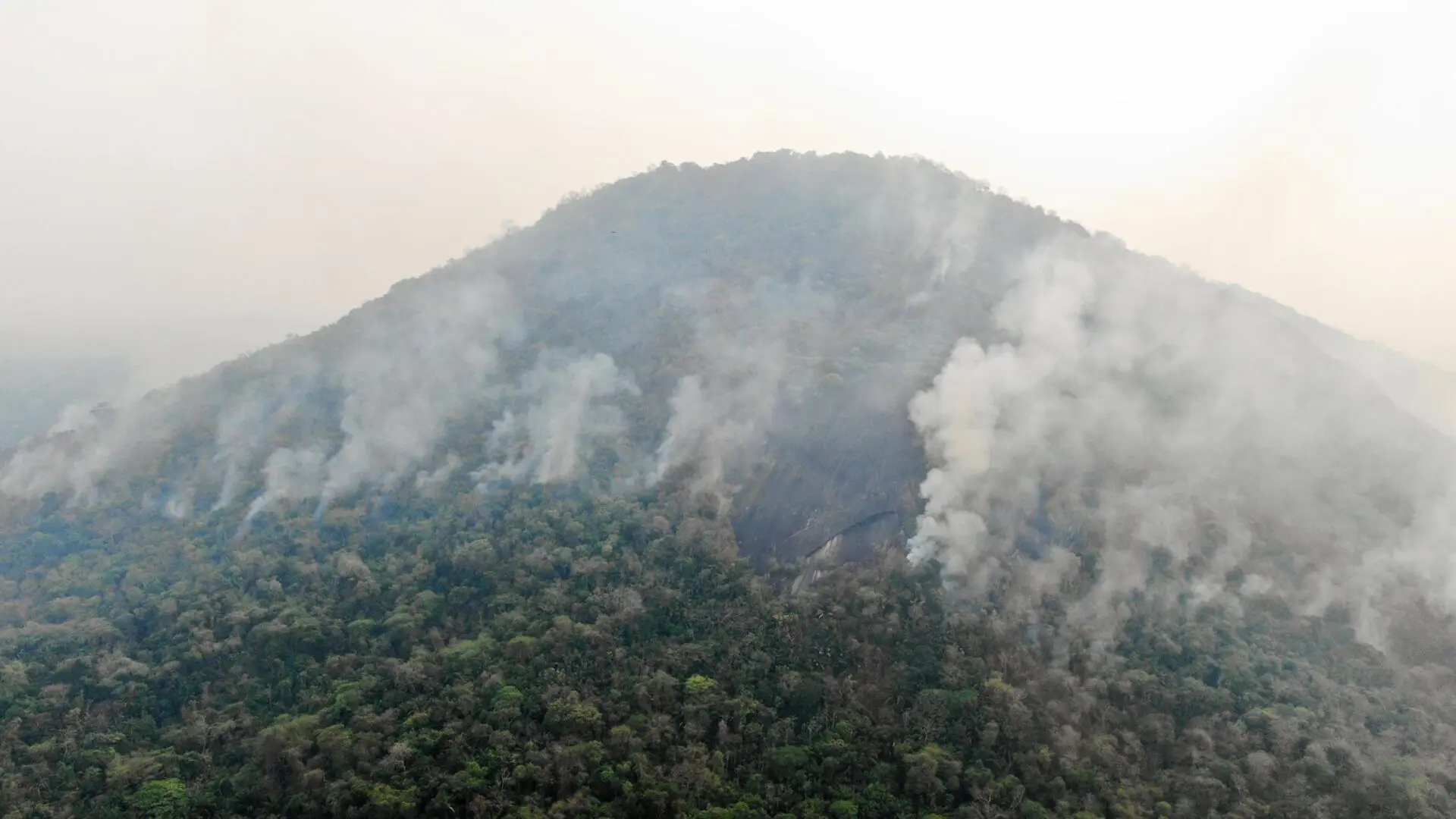
From January to April, Roraima had over 4,000 fires; the Malacacheta Mountain Range, home to the Indigenous Territory of the same name, was swathed in fire and smoke. Photo: Caique Souza/Ascom CIR
Report and text: Mayra Wapichana
Editing: Malu Delgado e Eliane Brum
Photos: Benjamim Mast
Photo Editor: Lela Beltrão
Fact-checker: Plínio Lopes
Proofreader (Portuguese): Valquíria Della Pozza
Spanish translation: José Luis Sansáns
English translation: Sarah J. Johnson/
Infographics: Rodolfo Almeida
Copyediting and finishing: Natália Chagas
Coordination of editorial workflow: Viviane Zandonadi
Editor-in-chief: Talita Bedinelli
Editorial director: Eliane Brum





